
Minox
Encyclopedia
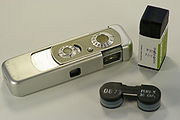
Walter Zapp
Walter Zapp was a Latvian inventor. His greatest creation was the subminiature camera .Zapp was born in Riga, Governorate of Livonia. In 1934, living in Estonia, he began developing the then subminiature camera by first creating wooden models, which led to the first prototype in 1936. It was...
, which Latvian
Latvia
Latvia , officially the Republic of Latvia , is a country in the Baltic region of Northern Europe. It is bordered to the north by Estonia , to the south by Lithuania , to the east by the Russian Federation , to the southeast by Belarus and shares maritime borders to the west with Sweden...
factory VEF
VEF
VEF, Latvian acronym for Valsts Elektrotehniskā Fabrika , is a manufacturer of electrical and electronic products in Riga, Latvia. VEF was the biggest Latvian factory in Soviet era and the leading communication technology producer in the Soviet Union...
(Valsts Elektrotehniskā Fabrika) manufactured from 1937 to 1943. After World War II
World War II
World War II, or the Second World War , was a global conflict lasting from 1939 to 1945, involving most of the world's nations—including all of the great powers—eventually forming two opposing military alliances: the Allies and the Axis...
, the camera was redesigned and production resumed in Germany in 1948. Originally envisioned as a luxury item, it gained wide notoriety as a spy camera
Espionage
Espionage or spying involves an individual obtaining information that is considered secret or confidential without the permission of the holder of the information. Espionage is inherently clandestine, lest the legitimate holder of the information change plans or take other countermeasures once it...
. Minox branched out into 110 format and 35mm cameras in 1976 and 1978, respectively. Minox continues to operate today, producing or branding optical and photographic equipment.
History
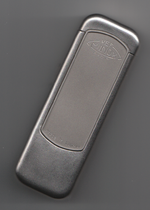
Walter Zapp
Walter Zapp was a Latvian inventor. His greatest creation was the subminiature camera .Zapp was born in Riga, Governorate of Livonia. In 1934, living in Estonia, he began developing the then subminiature camera by first creating wooden models, which led to the first prototype in 1936. It was...
in 1936. Zapp, a Baltic German
Baltic German
The Baltic Germans were mostly ethnically German inhabitants of the eastern shore of the Baltic Sea, which today form the countries of Estonia and Latvia. The Baltic German population never made up more than 10% of the total. They formed the social, commercial, political and cultural élite in...
, was born in 1905 in Riga
Riga
Riga is the capital and largest city of Latvia. With 702,891 inhabitants Riga is the largest city of the Baltic states, one of the largest cities in Northern Europe and home to more than one third of Latvia's population. The city is an important seaport and a major industrial, commercial,...
, then part of the Russian Empire
Russian Empire
The Russian Empire was a state that existed from 1721 until the Russian Revolution of 1917. It was the successor to the Tsardom of Russia and the predecessor of the Soviet Union...
. The family moved to Revel (now called Tallinn
Tallinn
Tallinn is the capital and largest city of Estonia. It occupies an area of with a population of 414,940. It is situated on the northern coast of the country, on the banks of the Gulf of Finland, south of Helsinki, east of Stockholm and west of Saint Petersburg. Tallinn's Old Town is in the list...
, Estonia
Estonia
Estonia , officially the Republic of Estonia , is a state in the Baltic region of Northern Europe. It is bordered to the north by the Gulf of Finland, to the west by the Baltic Sea, to the south by Latvia , and to the east by Lake Peipsi and the Russian Federation . Across the Baltic Sea lies...
) where he first took a job as an engraver before finding a position with a photographer. He became friends with Nikolai 'Nixi' Nylander and Richard Jürgens, and it was through discussions with these friends that the idea of a camera that could always be carried came to him. Nixi Nylander also coined the name MINOX and drew up the Minox mouse logo. Jürgens funded the original project but was not able to get support in Estonia for production. Jürgens contacted an English representative of the VEF
VEF
VEF, Latvian acronym for Valsts Elektrotehniskā Fabrika , is a manufacturer of electrical and electronic products in Riga, Latvia. VEF was the biggest Latvian factory in Soviet era and the leading communication technology producer in the Soviet Union...
(Valsts Elektrotehniskā Fabrika) electrotechnical manufacturing concern in Riga (by then independent Latvia
Latvia
Latvia , officially the Republic of Latvia , is a country in the Baltic region of Northern Europe. It is bordered to the north by Estonia , to the south by Lithuania , to the east by the Russian Federation , to the southeast by Belarus and shares maritime borders to the west with Sweden...
) who then arranged a meeting where Zapp demonstrated the Minox prototype (UrMinox), with a set of enlargements made from Ur-Minox negatives. Production began in Riga at VEF, running from 1937 until 1943.
The original Riga-made Minox had a brass chassis covered in a stainless steel shell, which telescopes to reveal or cover the lens and viewfinder windows, as well as to advance the film. It was equipped with a parallax correcting viewfinder, which was coupled to a Cooke triplet type Minostigmat 15 mm/3.5 lens. The lens was capable of focusing as close as 20 cm, and, due to its small image size, provided such depth of field at full aperture that a diaphragm was deemed unnecessary. The maximum focus zone was about one meter to infinity. In front of the lens was a metal foil curtain shutter, which was itself protected by a window. These were advanced features at the time for any camera, regardless of size. Dimensions: 80 mm × 27 mm x 16 mm; weight: 130 g.
Shortly after its introduction, the Minox was widely advertised in The European and American markets. It did not surmount the popularity of 35mm cameras (which were then referred to as "Miniature Cameras"), but did achieve a niche market. It also attracted the attention of intelligence agencies in America, Britain and Germany, due to its small size and macro focusing ability. There is at least one document in the public record of 25 Minox cameras purchased by the US Office of Strategic Services
Office of Strategic Services
The Office of Strategic Services was a United States intelligence agency formed during World War II. It was the wartime intelligence agency, and it was a predecessor of the Central Intelligence Agency...
intelligence organisation in 1942.
Ironically during World War II production of the Minox was put in jeopardy several times as Latvia fell victim to invasion by the Soviet Union, then Germany, and then by the Soviets again. Cameras were produced under both Russian and German occupation nevertheless, and the camera became both a luxury gift item for Nazi leaders as well as a tool for their spies. In the meantime, Zapp and his associates protected their interest in the product by patenting it in America and by searching for alternative production facilities in Germany.
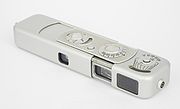
West Germany
West Germany is the common English, but not official, name for the Federal Republic of Germany or FRG in the period between its creation in May 1949 to German reunification on 3 October 1990....
. The new camera very much resembled the original, but was made with a plastic chassis covered by an aluminum shell. This greatly reduced its weight and, to an extent, cost. The camera continued to appeal to a luxury "gadget" market which broadened during the 1950s and early 1960s. It also continued to see use as an espionage camera by both sides during the Cold War
Cold War
The Cold War was the continuing state from roughly 1946 to 1991 of political conflict, military tension, proxy wars, and economic competition between the Communist World—primarily the Soviet Union and its satellite states and allies—and the powers of the Western world, primarily the United States...
. During this time, the Minox company continued to develop the camera, working with Gossen to develop a companion miniature exposure meter, as well as improved models such as the Minox B, which incorporated an even smaller Gossen-designed meter into the camera itself. The Minox B became the most popular and widely produced model of the line. Further developments included autoexposure, and the company developed an extensive line of accessories. These included flash guns, viewfinder attachments, tripod mounts, and copying stands, all increasing the camera utility in a variety of applications. One accessory even allowed the camera to use a pair of binoculars as a telephoto lens (see illustration). Limited editions of the camera were also produced in a variety of luxury finishes, such as gold plating. Standard cameras were also available in an optional black anodized finish.
The Riga Minox camera, along with the luxury finish postwar cameras, are now collector's items. Newer electronic versions, such as the Minox TLX, remain in production, essentially unchanged in features from the LX model since the late 1970s. With the introduction of the LX came significant redesign of the camera's basic controls. There is also the fully electronic entry level model, the EC, which has a very different internal design and has a fixed-focus lens. The production rate for these cameras is considerably slower than in former years, however, as Minox devotes more time to the design and marketing of OEM cameras under the Minox brand.
Minox was acquired by Leica in 1996, but a management buyout
Management buyout
A management buyout is a form of acquisition where a company's existing managers acquire a large part or all of the company.- Overview :Management buyouts are similar in all major legal aspects to any other acquisition of a company...
in August 2001 left Minox an independent company again.
Although primarily marketed as a luxury item, the Minox was also used as an espionage
Espionage
Espionage or spying involves an individual obtaining information that is considered secret or confidential without the permission of the holder of the information. Espionage is inherently clandestine, lest the legitimate holder of the information change plans or take other countermeasures once it...
camera. Its close-focusing lens and small size made it perfect for covert uses such as surveillance or document copying. The Minox was used by both Axis
Axis Powers
The Axis powers , also known as the Axis alliance, Axis nations, Axis countries, or just the Axis, was an alignment of great powers during the mid-20th century that fought World War II against the Allies. It began in 1936 with treaties of friendship between Germany and Italy and between Germany and...
and Allied intelligence agents during World War II
World War II
World War II, or the Second World War , was a global conflict lasting from 1939 to 1945, involving most of the world's nations—including all of the great powers—eventually forming two opposing military alliances: the Allies and the Axis...
. Later versions were used well into the 1980s. The Soviet spy John A. Walker Jr.
John Anthony Walker
John Anthony Walker, Jr. is a former United States Navy Chief Warrant Officer and communications specialist convicted of spying for the Soviet Union from 1968 to 1985, at the height of the Cold War...
, whose actions against the US Navy cryptography
Cryptography
Cryptography is the practice and study of techniques for secure communication in the presence of third parties...
programs represent some of the most compromising intelligence actions against the United States
United States
The United States of America is a federal constitutional republic comprising fifty states and a federal district...
during the Cold War
Cold War
The Cold War was the continuing state from roughly 1946 to 1991 of political conflict, military tension, proxy wars, and economic competition between the Communist World—primarily the Soviet Union and its satellite states and allies—and the powers of the Western world, primarily the United States...
era, used a Minox C to photograph documents and ciphers. An 18 inches (457.2 mm) measuring chain was provided with most Minox cameras, which enabled easy copying of letter-sized documents. The espionage use of the Minox has been portrayed in Hollywood movies, and some Minox advertising has played up the "spy camera" story.
A Minox B, operated by remote trigger and protected in a special housing, was used to inspect the interior of the SL-1
SL-1
The SL-1, or Stationary Low-Power Reactor Number One, was a United States Army experimental nuclear power reactor which underwent a steam explosion and meltdown on January 3, 1961, killing its three operators. The direct cause was the improper withdrawal of the central control rod, responsible for...
nuclear reactor after it experienced an internal steam explosion in 1961. This camera and housing were shown in the film report released following the accident investigation.
Technical details of Minox 8×11 cameras
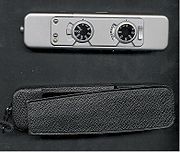
135 film
The term 135 was introduced by Kodak in 1934 as a designation for cartridge film wide, specifically for still photography. It quickly grew in popularity, surpassing 120 film by the late 1960s to become the most popular photographic film format...
film, and unlike 35 mm film, it has no sprocket
Sprocket
A sprocket or sprocket-wheel is a profiled wheel with teeth, cogs, or even sprockets that mesh with a chain, track or other perforated or indented material. The name 'sprocket' applies generally to any wheel upon which are radial projections that engage a chain passing over it...
holes. This film strip is rolled up on a supply spool in the supply side chamber of a small twin chamber cartridge, with the film leader taped to a take-up spool in the take up chamber; the film strips can be up to 50 frames in length for Riga Minox and Minox II, III, IIIs and B, from Minox BL and C onward, the Minox film cartridge holds, 15, 30, or 36 exposures. Early Minox cameras from Minox II to earlier Minox B were equipped with a four element three group Complan
Complan
Complan Foods is a British company that makes powdered milk energy drinks. It was acquired by Danone in 2011. In India the Complan brand is owned by the H. J. Heinz Company.-History:...
lens designed by ex- Leica lens designer Arthur Seibert. The Complan lens has a curved film plane, hence in these cameras, the negative must be held in an arc to improve the edge-to-edge sharpness of the image. The Minox enlarger also holds the negative in this same curve. Later models, began with late model Minox B to the current model TLX, using the 15 mm/3.5 4 element 3 group flat field Minox lens, and the negative was held flat.
The early Minox cameras from Riga to Minox B and BL, were equipped with mechanical shutter, later model Minox cameras have an electromagnetic shutter. When closed, the viewfinder and lens windows are protected. Complan lens and Minox lens are unit focusing lens, focusing from 8 inches (20cm) to infinity through precision gear linked to a focusing dial on top of the camera. All Minox cameras except the EC has parallax correction viewfinder, when the focusing dial moves, the viewfinder moves in tandem to correct for parallax. From the Riga to Minox B, the film counter counts up to 50, from Minox BL, C to CLX, the film counter counts down from 36/30/15. For mechanical Minox 8x11 cameras, a separate shutter speed dial sets the shutter speed from 1/2 to 1/1000 second, plus B and T (BL has no T). For electromagnetic shutter cameras, the shutter dial starts with 1/15 sec end with 1/1000 (Minox C), or starts with 1/30 and ends with 1/2000 (Minox LX/TLX/CLX); the electromagnetic Minox camera also has an 'A' setting for automatic exposure, controlled by the built in exposure meter. Above the viewfinder is a filter bar used to slide a green or an orange filter in front of the lens; starting with the BL, there is only a Neutral Density filter. For Riga Minox to Minox B, the film advances each time the camera is closed, regardless whether a picture is taken or not. Opening the camera causes the pressure plate to press the film into a concave or flat (depending on the model) surface to stiffen thin emulsions for better clarity. When the camera is closed, the pressure plate moves back from the film plane, thus allowing the film strip to move freely to advance to the next frame. From Minox BL onward, the camera is equipped with a "freewheeling" mechanism, such that the film advances one frame only when a picture is taken, otherwise, closing the camera does not advance a frame. Minox BL uses a PX625 button cell to power the CdS exposure meter; Minox C, LX, EC, used 5.6v PX27 mercury battery to power the exposure meter and electromagnetic shutter, TLX, CLX, ECX use four 1.5v 386 silver oxide button cell in an adapter; this adapter combo can also be used to replaced the discontinued 5.6v PX27 battery for Minox C, LX and EC.
Major production runs
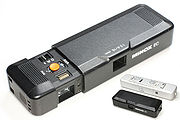
- Riga (attempts to call this Model I failed)
- A (Europe there was no distinction made between the three A models)
- II
- III
- IIIs - flash synch
- B - ultralight aluminium shell, seleniumSolar cellA solar cell is a solid state electrical device that converts the energy of light directly into electricity by the photovoltaic effect....
meter, produced from 1958 to 1972 - C - introduced in 1969, electronic, used by spy John A. Walker, Jr.
- BL - 1972 with cadmium sulphidePhotoresistorA photoresistor or light dependent resistor is a resistor whose resistance decreases with increasing incident light intensity. It can also be referred to as a photoconductor or CdS device, from "cadmium sulfide," which is the material from which the device is made and that actually exhibits the...
meter (requiring a battery), no longer winds film with each open/close cycle - LX - electronic, in anodized aluminium, black aluminium, gold and platinum finish.
- EC
- ECX, replacing EC
- MX, with flash
- TLX, titanium titanal eloxat coated
- CLX, chrome plated, limited edition
Special edition runs
- AX - similar in size the A (all mechanical) and built from BL parts with an LX shell, versions in chrome, black and gold
- LX Sterling - 925 sterling silver hallmarked
- LX Selection - gold with black dials
- LX Gold II - anniversary edition, all gold, with Walter Zapp's signature
- LX Platin - Limited edition platinum Minox LX
- CLX - with Walter Zapp's signature
- LX 2000 - brass black anodized with gold trim
- Aviator - black anodized with luminous dials, logo and script limited edition of 300
- MHS EC - Minox Historical Society EC with MHS logo limited edition of 100
- MinoxClub EC - 1st German Minox club EC in Riga blue with club logo, limited edition of 111.
- LX 100th Anniversary Edition - polished chrome with Walter Zapp's commemorative coin
Minox 8×11 accessories
- Minox tripod, ver 1 and 2
- Minox tripod adapter for Riga, II,IIIs, B,BL,C
- Minox copy stand
- Minox waist level finder
- Minox 90 degree mirror
- Minox film slitter
- Minox projectors
- Minox enlargers
- Minosix selenium exposure meter
- Minox flashgun
- Minox electronic flash
- Minox binocular adapter
- Minox microfilm reader
- Minox daylight development tank with thermometer
- Minox negative viewer and cutter
- Minox film sleeves
- Minox battery adapter, for replacement of discontinued PX27 5.6v mercury battery used in electromagnetic Minox cameras.
Minox 35mm cameras

Polycarbonate
PolycarbonatePhysical PropertiesDensity 1.20–1.22 g/cm3Abbe number 34.0Refractive index 1.584–1.586FlammabilityV0-V2Limiting oxygen index25–27%Water absorption – Equilibrium0.16–0.35%Water absorption – over 24 hours0.1%...
bodied 35 mm camera designed by Professor Fischer of Vienna University: the Minox EL, the first one in Minox 35 mm series. These compact cameras featured a drawbridge style lens cover which when lowered brought forward a 35 mm focal length f/2.8 four element 3 group Tessar type Minotar/Minoxar lens with between the lens leaf shutter and diaphragm, a center positioned viewfinder, two stroke film winder lever and a film rewind knob. The camera offered aperture priority exposure with the option of manual settings, among them the Minox 35ML and Minox M.D.C offer program mode (P mode) exposure in addition to aperture priority. The 35 mm/2.8 Minotar/Minoxar lens was very sharp, with low distortion, the camera's metering-system's capability to produce excellent results especially under low-light conditions was outstanding - using exposure times of up to two minutes. Minox 35 camera back can be removed for loading or unloading film. Some models have a 10 sec timer switch and a 2x backlit exposure switch. When the timer is engaged, a flashing LED indicates the timer counter is counting down, for the last two sec, the flash interval shortened.
Until today the Minox 35 cameras are the smallest cameras for the standard 35mm film format. The design was inspired by the Rollei 35
Rollei 35
The Rollei 35 is a 35mm miniature viewfinder camera built by Rollei. The original Rollei 35, when introduced at Photokina in 1966, was the smallest existing 135 film camera. Still today, the Rollei 35 series remain the second smallest 35 mm camera after the Minox 35...
, which had been the smallest 35mm camera for eight years. The Rollei 35 is only slightly bigger, but much heavier than the Minox 35 cameras.
- Minox EL, 1974
- MINOX GL, 1979-1981
- MINOX GT 1981-1991
- MINOX GT-Golf 1984
- Minox GT-Sport
All the above model use 5.6 v PX27 battery, can be replaced with two CR 1/3N 3V Lithium Battery
with an adapter.
- MINOX GT-E 1988-1993 with built in UV filter.
- MINOX GSE 1991-1994
- MINOX PL 1982-1983
- MINOX ML 1985-1995
- MINOX AL 1987-1988
- MINOX AF 1988-1990
- MINOX MB 1986-1999
- MINOX MB Touring 1900
- MINOX Goldknopf 1991-1993, with a solid gold button for shutter release.
- MINOX M.D.C 1992-1995 This is the flag ship of Minox 35 mm series. MDC differs from all other models by its anodized aluminium shell over Macrolon body; with two styles: a gold plated model and a titanium coated model. MDC has a multicoated Minoxar 35 mm/2.8 lens, all other functions are identical to Minox 35ML. Due to the extra metal shell, the dimension of Minox M.D.C is slightly larger than other Minox 35 cameras.
- MINOX MDC gold Collection 1993-1994
- MINOX GT-X 1998-1999
- MINOX GT-E(II) 1998-2001
- MINOX GT-S 1998-2004
- MINOX AF mini
- MINOX AF-90
All the above, except ML, MDC uses 2x CR 1/3N 3V Lithium batteries or 6V SPX27 silver oxide battery. ML, MDC use 6V PX28 battery. Accessories for Minox 35 includes, UV filter, ND filter
lens hood, eveready leather case and dedicated electronic flash.
Other products
MINOX 110S, a 110 film110 film
110 is a cartridge-based film format used in still photography. It was introduced by Kodak in 1972. 110 is a miniaturised version of Kodak's earlier 126 film format. Each frame is , with one registration hole....
format camera was also once sold. The Minox 110S has a Carl Zeiss Tessar 25 mm/2.8 unit focusing lens, and magicube flash. It is the only camera with a rangefinder made by Minox. An external electronic flashgun was also available. Users report that the 110S provides particularly good results on modern 110 film.
Matching the size of the slide film for the 8×11 MINOX cameras, MINOX also produced slide projector
Slide projector
A slide projector is an opto-mechanical device to view photographic slides. Slide projectors were common in the 1950s to the 1970s as a form of entertainment; family members and friends would gather to view slide shows...
s ending with the auto-focus HP24 model.
Today, a range of digital
Digital photography
Digital photography is a form of photography that uses an array of light sensitive sensors to capture the image focused by the lens, as opposed to an exposure on light sensitive film...
cameras is offered along with binoculars and other optics. The few 35 mm cameras now offered are of the "point and shoot" style:
- MINOX M*142
- MINOX M*142 DB
- MINOX CD-25 silver
- MINOX CD-25 black
- MINOX CD-29 silver
- MINOX CD-29 black
- MINOX CD-70 silver
- MINOX CD-70 black
- MINOX CD-112 silver
- MINOX CD112 black
- MINOX CD-128
- MINOX CD-140
- MINOX Edition 140
- MINOX CD-150
- MINOX CD-155
The original 8×11mm range is still in limited production. Minox has expanded its range of 8×11 models by offering Minox-badged
Badge engineering
Badge engineering is an ironic term that describes the rebadging of one product as another...
cameras styled as miniatures of famous classic film cameras of the past, manufactured by Sharan Megahouse of Japan, including:
- Leica If
- Leica IIIf
- Leica M3
- Rolleiflex TLR
- Zeiss Contax I
- Hasselblad SWC.
The digital camera offerings also include similar miniatures:
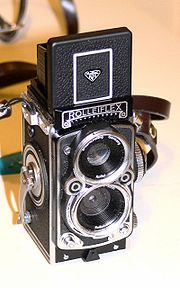
- DCC Rolleiflex AF 5.0
- DCC Minox Leica M3
- Rolleiflex minidigi (out of production)
- At PhotokinaPhotokinaThe photokina is the world's largest trade fair for the photographic and imaging industries. The first photokina was held in Cologne, Germany, in 1950, and it is now held biannually in September at the koelnmesse Trade Fair and Exhibition Centre...
in 2008 Minox announced a new subminiature digital camera called the DSC, (Digital Spy Camera) with a 3 megapixel sensor that outputs 5 megapixel interpolated images. It includes some design cues of the Minox LX but otherwise does not resemble the original cameras.
Further reading
- Robert Wallace and H. Keith Melton, with Henry R. Schlesinger, Spycraft: The Secret History of the CIA's Spytechs, from Communism to al-Qaeda, New York, DuttonDutton- Places :*Dutton, Alabama, town in the United States*Dutton, Cheshire, village in England*Dutton, Lancashire, village in England*Dutton, Montana, town in the United States*Dutton/Dunwich, Ontario, town and municipality in Canada*Dutton, South Australia...
, 2008. ISBN 0525949801
External links
- Company web site
- Minox Historical Society
- Minox 35 mm Cameras(in German)
- Minox 35mm Cameras(in English)
- Models and serial nos. of all Minox 8x11 cameras
- Surviving VEF Minox Riga Serial No.
- Variations in subminiature cameras, including the full range of Minox 8x11 and 35mm cameras models, accessories and a detailed serial number tables
- Minox Digital Camera Database

